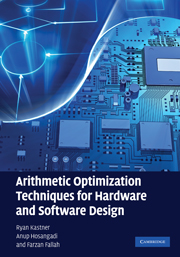6 - Polynomial expressions
Published online by Cambridge University Press: 03 May 2010
Summary
Chapter overview
This chapter presents some of the issues in the optimization of polynomial expressions. The chapter starts with an introduction to polynomial expressions and their possible optimizations, with illustrative examples. Then, the details of some techniques for manipulating polynomial expressions are presented. This is followed by a description of algebraic techniques used for the optimization of multiple-variable polynomial expressions. The usefulness of these techniques is demonstrated through experimental results. Finally, the chapter presents an ILP-based approach to obtain the optimal solution to the problem.
Polynomial expressions
A polynomial is an expression constructed from one or more variables and constants using the operations addition, subtraction, multiplication, and raising to the power of nonnegative integer numbers. Examples of polynomial functions are: x3 – 6x2 + 10 and x3y2 + 15x2y2 – 6zx4. The first is a univariate polynomial, while the second is a multivariate polynomial. Univariate polynomials consist of at most one distinct variable, whereas multivariate polynomials can contain any number of variables.
A polynomial function can be thought as a summation of terms (both positive and negative). The degree of a term is the sum of the powers of each variable of the term. The degree of the term with the highest degree is the polynomial's degree. For example, the degree of the first aforementioned polynomial is 3, while the degree of the second polynomial is 5.
Polynomial functions are used to encode a number of problems in basic sciences such as chemistry and physics.
- Type
- Chapter
- Information
- Publisher: Cambridge University PressPrint publication year: 2010

